Sexing chicks. 10 ways that work and 8 that do not.
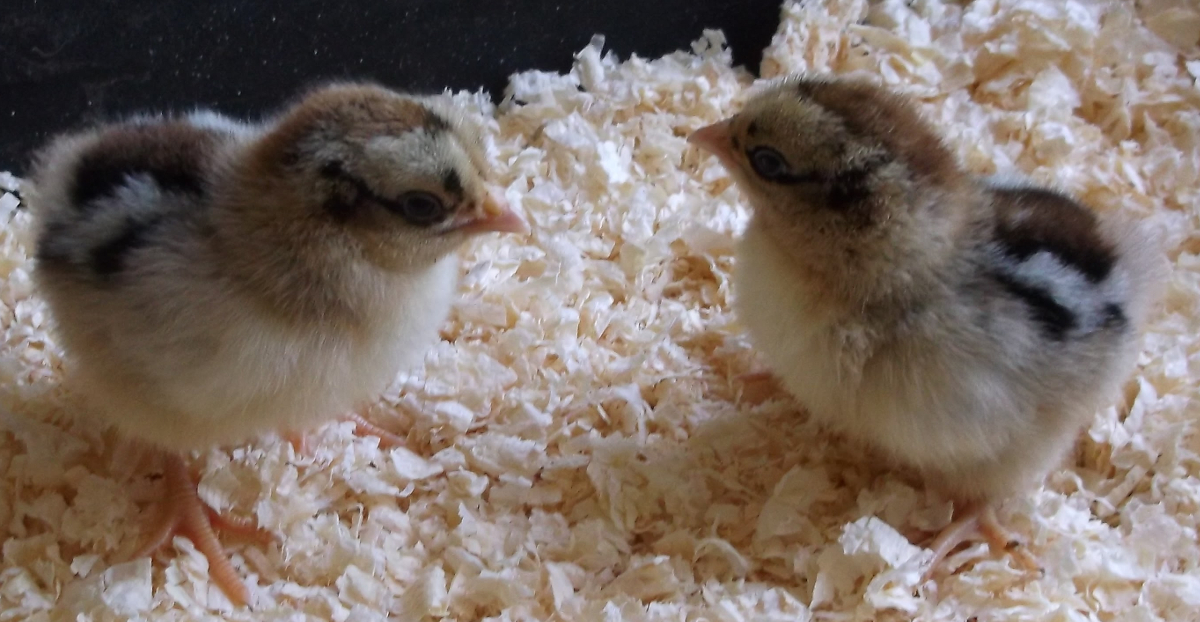
Vent and DNA sexing is the only accurate methods of sexing chicks, all the other methods of determining the sex of your baby chickens are breed or characteristic dependant. Most chicken breeds cannot be sexed by the average keeper at hatching.
Table of Contents
- What are the methods of sexing chicks?
- Why sex chicks?
- Feather sexing chickens:
- Vent Sexing chicks:
- Pattern sexing chicks:
- Head spot sexing day old chicks:
- Sex linked Sexing of chicks:
- Eye line sexing:
- Auto-sexing breeds:
- Specific gene sexing:
- Leg colour sexing chicks:
- Barred feather sexing:
- Ways you can't sex baby chicks:
- When is the best time to sex chicks?
- How do you tell if an egg is a rooster or hen?
- Sexing older chickens:
- Conclusion:
What are the methods of sexing chicks?
- Feather sexing. The rate at which wing feathers grow in certain breeds can show the males from the females.
- DNA sexing. Send a DNA sample to a laboratory for testing. this method is expensive.
- Vent sexing. All poultry including chickens can be vent sexed. It is a difficult process that requires much training and care and is beyond most backyard keepers.
- Pattern sexing. In some breeds the pattern on the chick can be used to sex the chick.
- Head spot sexing. In some breeds the shape of the head-spot is an accurate sexing method.
- Sex link sexing. Certain crosses can be used to produce easily sexed chicks.
- Eye line sexing. In Wyandottes the eyeline length can be used to show the sex of the bird.
- Auto-sexing. Some breeds have been bred to produce sex-able chicks.
- Specific genes. The late feathering gene can be used to determine sex in some circumstances.
- Leg colour sexing. The extent and definition of leg colour can be used to sex some chicks.
- Barred chickens sexing. Feather patterns in chickens like the Barred Rock can indicate sex.
Why sex chicks?
Young chickens need to be sexed for several reasons. If the birds are to be used for meat production males and females mature at different rates so separating them out when they hatch makes financial sense as all the birds which are together and don't need to be processed separately.
With layer chickens the males are useless as they cannot be used for food never lay eggs. They are that separated out when they hatch and destroyed. This saves the cost of feeding the birds until they grow up and the secondary characteristics show.
Chickens are sexed when young to avoid the cost of raising surplus males. The cost of incubating and hatching males and then sorting them from the hens is huge. Laying hens can't be raised for meat so around 50% of all eggs incubated and chicks hatched in the egg industry are wasted.
Feather sexing chickens:
Feather sexing is the ability to determine the gender of a newly hatched chick based on the rate of growth of its wing feathers.
Feather sexing is a trait that is sex linked and works only if the chick's father is of a breed that grows feathers rapidly and its mother is of a breed that grows feathers slowly.
If the parent female is feather sex-able, her offspring won't be.
Only works during a short window when the chicks are between 24 and 72 hours old. Before or after this time period it becomes progressively more inaccurate.
How to feather sex chicks:
Hold the chick and carefully extent the wings and spread the feather between finger and thumb until the spread out into a fan.
Below: The feathers of day old chicks.
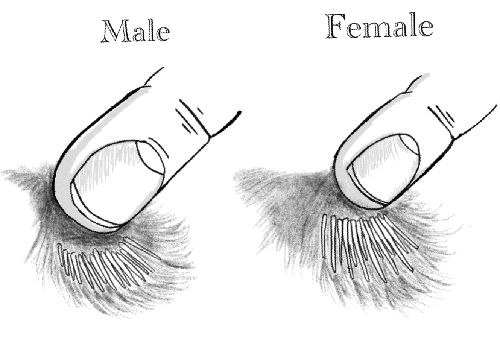
If the feathers, primaries and coverts, are two different lengths it is a pullet and if the are the same length it is a male.
Confusion can happen because in the male the coverts can be longer than the primaries so you have to know which feathers are which.
The coverts are the upper layer and the primaries are the lower layer of feathers.
Advantages of feather-sexing:
Identification of sex in one-day-old chicks by feather length has a few advantages over vent sexing:
- Special chicken sexers are not required.
- Risk of infection or manipulation damage is reduced.
- There is a lower probability of mistakes.
- Feather sexing is faster than vent sexing.
- less equipment is needed such as tables and lamps.
- The cost of sexing is much lower.
Vent Sexing chicks:
Vent sexing is he most accurate method of sexing poultry and an experiences operative can sex hundreds of chicks an hours with an accuracy of 98%.
Vent sexing is a skilful job and not easy for the average backyard keeper. It is the method the majority of hatcheries use before shipping chicks.
How to vent sex chickens:
Vent sexing chickens it's something that has to be done with great care. skilled workers can do two of the time and several hundred an hour but the back yard keeper would probably struggle to do a few a minute.
Pick the chick up carefully and turn it upside down . The body of the chick is then squeezed gently to expose the structure of the vent.
Below: Vent sexing a chick.
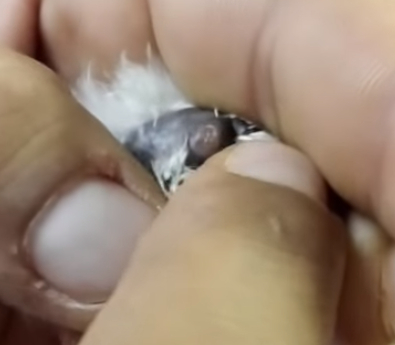
Vent sexing requires special equipment and training and the opportunity to harm the chick is high.
The chicken sexer then examines the vent of the chick looking for certain structures associated with it being either male or female.
Pattern sexing chicks:
Some chicks like the Welsummer can be pattern sexed.
You can tell the sex of a Welsummer chick from day old, the females have a broad dark brown stripe going from the top of their heads along their backs, they also have 'eyeliner' a dark brown stripe from their eye, the males have a plainer face and much lighter colouring.
We usually advise people not to treat Welsummer in the auto-sexing way people treat Legbars - just because a chick has eyeliner and a dark stripe down it's back it can still be male....we usually suggest to look for chest feather colouration at around 3-4 weeks old - if you get anything that looks like a mix of blacks and dark browns compared to a more solid lighter brown colouring then the latter will be girls, the former boys.
Below: Welsummer chicks. The wide dark strip is a hen and the narrow strip a male.
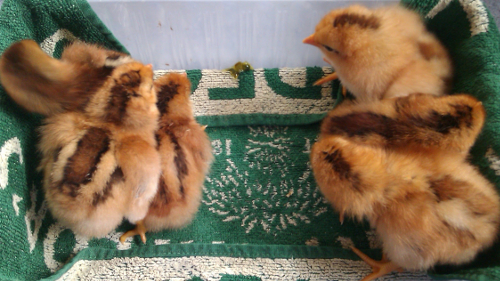
In the example above there are four hens and two cockerels.
Not every line of Welsummer are sex-able. Some more so than others. My line is pretty easy to see the differences. I was wrong on one last year though. I had it marked as a male and it was a female
Head spot sexing day old chicks:
This only works in breeds with a head-spot like the barred Rock.
Barred Rock chicks are basically black with superimposed splashes of white. These white splashes are in reality areas from which the black pigment has been restricted. The white splashes are caused by an inherited "barring" factor or gene, the same factor which causes white bars on the adult feather.
These white areas are regionally distributed; that is to say the white occurs in certain definite areas like the ventral side or belly, throat, wing tips and top of head. In pure-bred Barred Rocks the male chick always carries two doses of the white bar factor, the female only one, and this tends to make the male chicks lighter in down colour than the female.
However the males are not sufficiently lighter than the females to allow them to be sexed on this basis. It is the shape of the white head spot which is the chief distinguishing point between the sexes.
The male head spot:
In males this spot tends to be spread or scattered and generally takes the basic shape of a circle enclosing a central dark area.
Below: Examples of head spots in male chicks.

This white circle is the basic pattern in all males but its expression is subject to very considerable variation and it is the numerous variations from this basic pattern which one must learn to recognise.
The female head-spot:
In contrast to males, females have no basic circle and no clumped fore white. With them the head spot is generally an almost solid or continuous white spot which may be well spread as in chick or rather restricted as in chick of the same figure.
Below: A selection of female head spots in barred rock chicks.
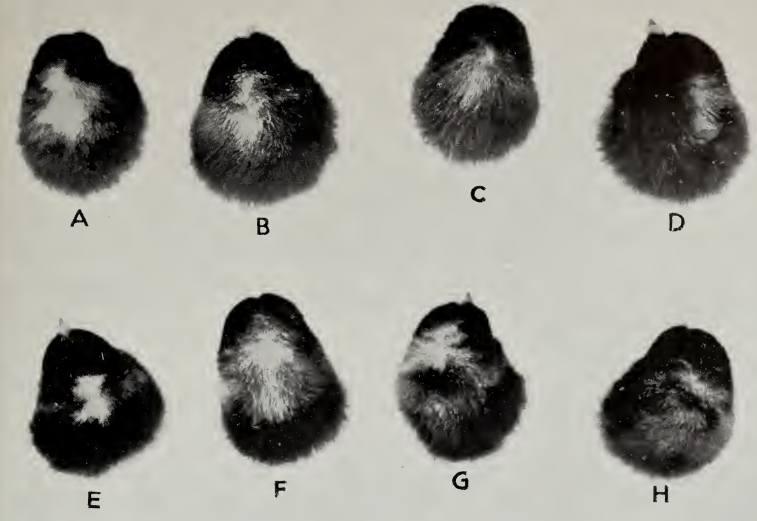
The female spot also tends to be a soft or bluish white colour in contrast to the harsher yellowish white of the male. This last method of differentiation cannot be relied on to any great extent since many females have yellowish spots.
Sex linked Sexing of chicks:
Sex link chickens are a type of hybrid chicken breed whose colour at hatching is differentiated by sex, thus making chick sexing an easier process. Hybrid chicken breeds are the result of cross breeding two or more heritage or pure-bred chicken breeds, usually to produce offspring that lays more eggs, produce more meat
There are several different types of sex linked chickens, most do not breed true in second generations. These types include red stars, golden comets, red sex links, cinnamon queens, and black stars.
Black sex link breeding:
Black sex links are created by breeding a barred hen to a non barred rooster. Typical breeding is a Barred Plymouth Rock hen under a Rhode Island Red, or New Hampshire red rooster. In this cross, the hens do not receive a barring gene (the barring gene is only located on the male chromosome.) The cockerels will inherit one barring gene from the mother (from her male chromosome). When the chicks hatch from this breeding, the males will have white dots on their heads, females will have all black heads
Example - Black sex-link like "Black rocks" are a cross between unique specially bred hybrid strains of Rhode Island Red rooster (but any non-white and non barred rooster may be used for other black sex-link crosses) and a Barred Rock hen (which carry both extended black and barring genes).
Red Sex Link Breeding:
Several breeds are used in red sex link breeding, they are usually named by parents used. When these chicks hatch, the males will be white, the females will have a red cast. The males will grow to be mostly white, with some red spots showing through, females will be mostly red with some white spots especially in the tails and lower wings.
Example - Red sex-links are a cross between a Rhode Island Red or New Hampshire rooster and a White Rock (This variety pair is known as a Golden Comet), Silver Laced Wyandotte, Rhode Island White, or Delaware hen.
Eye line sexing:
The female has an eye line, a dark line extending beyond her eye towards her ear is dark and very well defined. On the male, that same line is light and blurry.
Below: An example of eye lines in chicks. It is not always as clear cut as you would like.
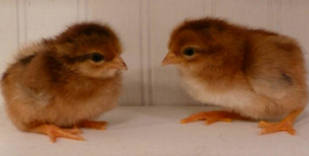
The males can have eye line too, but it doesn't go all the way down the neck and along their back but finishes earlier.
Auto-sexing breeds:
Breeds like the Cream Crested Legbar can be sexed by looking at the down colour of the chicks. These chickens are auto-sexed at hatch by their down colour. The males have a yellow dot on their heads
Below: Shows the difference between the male, lighter in appearance and has a yellow spot or smudge on the top of his head, and the female, darker back with darker stripes.
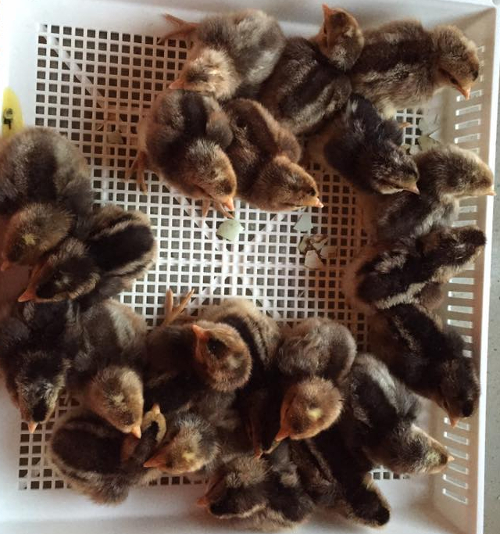
Specific gene sexing:
This is different to the day old feather sexing above and happens much later at 10 days to 2 weeks of age.
Delayed-feathering in chickens is a genetically determined delay in the first weeks of feather growing, which occurs normally among the chicks of many chicken breeds.
Female chicks have a slightly faster feathering than males and feather up in different ways.
Sex-linked feathering is controlled by locus K on the sexual chromosome, with four known alleles in the following dominance order: Kn > Ks > K > k+.
Kn (extremely slow-feathering) - Kn ("naked") is the most dominant of the allelic series which controls feather growth rate. It is a gene whose action on feather growth is quite extreme. Birds carrying this gene are nearly naked during juvenile life and in some cases females remain nearly naked well into adult life. One-day-old chicks lack primary and secondary remiges. Kn also has other pleiotropic effects, as a reduction in comb size and hypertrophy of the uropygial gland
Ks (slow-feathering) - Ks ("slow") is another dominant allele of the allelic series which controls feather growth rate. In one-day-old chicks primary remiges are shorter than the coverlets. Plumage growing is greatly delayed during the first weeks of juvenile life, but birds of both sexes completely finish plumage growing at twelve weeks of age. This allele has no effect on adult plumage.
K (delayed-feathering) - K is another dominant allele of the allelic series which controls feather growth rate. One-day-old chicks have primary remiges and coverlets of the same length and in 8- to 12-day-old chicks rectrices are not yet developed.
k+ (fast normal-feathering) - k+ is the most recessive of the allelic series. One-day-old chicks pure for this allele have the primary remiges evidently longer than the coverlets while 8- to 12-day-old chicks show their rectrices well developed, and they later complete feather growing long before those chicks carrying K. k+ is responsible for the fast normal-feathering found in most egg-type breeds like Leghorn, Minorca, Ancona and many others.
Leg colour sexing chicks:
There are two rather macabre plates that are just the pictures of the legs from an old poultry book that go with this section but I have chosen not to publish them on this page.
You can see or download them here( Barred rock female leg colours) and here ( barred rock male leg colours).
The female is usually black and white or perhaps it should be described as dark and light. The dark colour is on the upper part of the shank next the body and extends down-ward, stopping anywhere from part way down the shank to part way out on the toes.
The distinguishing feature of these typical female legs is the fact that the black colour has a clear cut and definite margin. That is to say it ceases suddenly rather than merging gradually into the white or flesh colour of the remaining shank and toes.
In the male the typical leg colour for males is even throughout the length of both shank and toes. From left to right they progress from a pure flesh or slightly yellow colour to a fairly dark slate; the two middle pairs being inter-grades between the two extremes. The proportion of light legs, that is those on the left as against the darker legs to the right, depends on the breeding of the chicks.
Barred feather sexing:
In pure-bred Barred Plymouth Rocks it is well known that the partly grown and adult males can be readily distinguished from the females by the type of barring on the feather.
On the males both the white and black bars are narrower than on the females and the white is, relative to the black, wider than in the females. Thus males appear finer barred and appreciably lighter on the whole than females. The cockerel baby chicks tend to be lighter in down colour than the pullets but this is not a 100% accurate approach.
Below: Very dark feathers are girls. Those with lighter feathering - more white barring - seem to be roosters.
Female Barred Rock hens are darker in colour. More pronounced lines on their wings. Their legs and feet are darker, as well. Their comb is smaller and not as red. Male Barred Rock roosters have light coloured feathers and legs
Ways you can't sex baby chicks:
Here are a few methods of sexing chicks that you should not bother with. At least 3 of them will get you questioned by the SPCA.
There are quite a few odd methods that vary from the sublime to the ridiculous, some are even cruel. If any of these methods actually worked then they would be used in the commercial layer industry, and they are not, so they don't.
Breast colour. This is a common misconception when it comes to sexing Barnevelder chicks. The theory is that a white breasted chick is a hen but as I have sexed over six thousand Barnevelder chicks I can quite safely say that is isn't a way of sexing birds.
Egg shape. The shape of an egg cannot determine the gender of the embryo inside. A single study found that there was a slight correlation between the shape index and egg volume were more informative for the likelihood of the sex of hatching chick. Here's the thing, the correlation was only 18% which is tiny and not worth the effort. The study itself concluded that "The effect of egg weight and replicate number was not significant on the sex of the hatching chick."
Divining. In much the same way as some look for water, a weight on a piece of string is held over the chicks head, it will rotate or spin one way for a hen and the other way for a cockerel.
Incubation temperature. The temperature in the incubator can not effect the ratio of males to females, that is genetically determined at fertilisation. Very high or low incubator temperatures can effect the proportion of which sex go on to hatch.
Hanging chicks by the head. Inaccurate and cruel.
Apparently if you hang a chick like this and it lifts and kicks it's legs and flaps it's wings it is female. If it just hangs it is male.
Below: A hen.
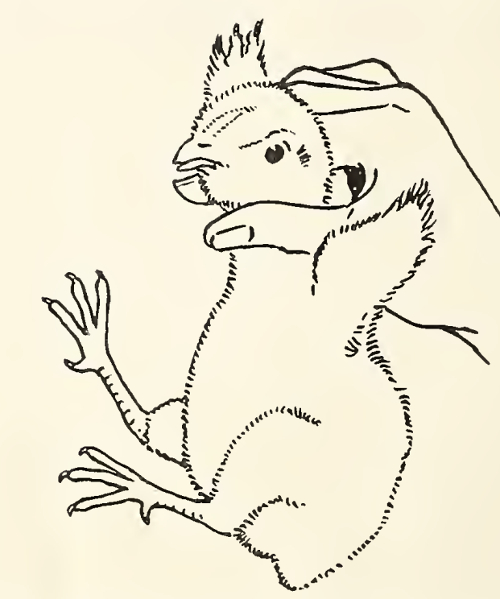
Below: A cockerel.
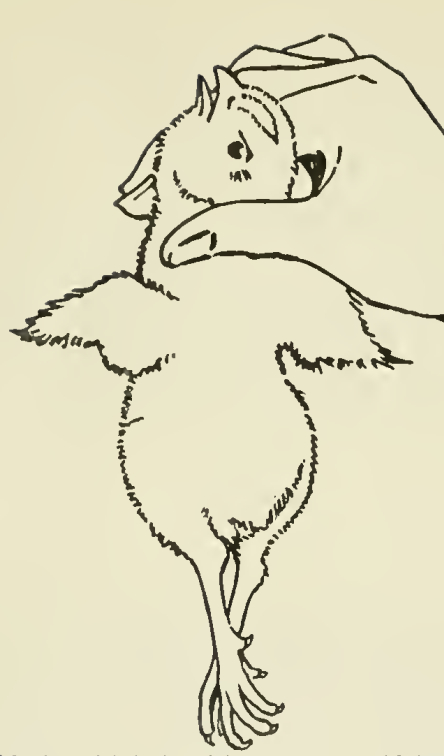
Hanging chicks by the feet. Don't try this at home either. Chickens do not have a diaphragm and can not breathe when held upside down.
Apparently if you picked a chick up by it's feet and it pulled itself up and flaps it's wings then it is a hen and if it just hangs there then it's a male.
Below: A hen.
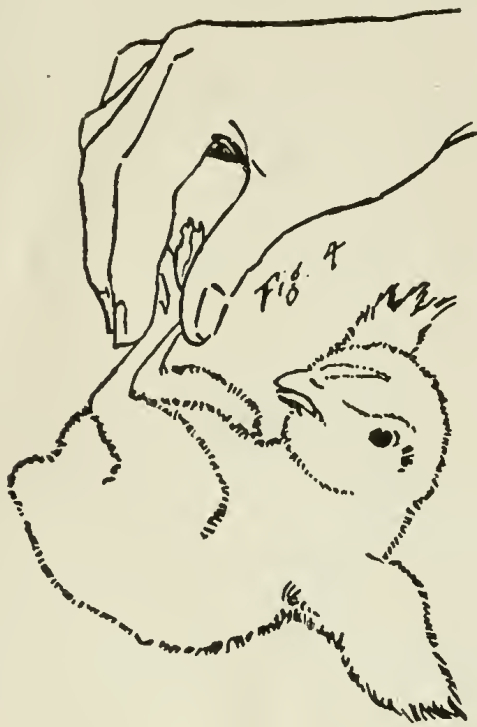
Below: A cockerel.
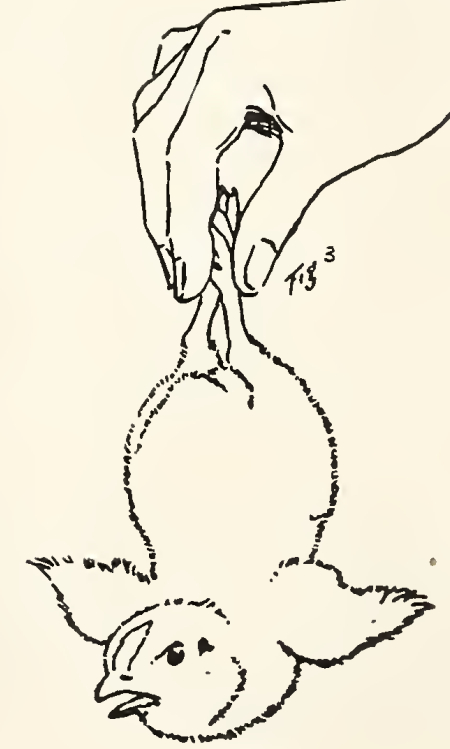
I found this method from old poultry book: "In the case of young chickens a slight tap on the head will bring a sharp piercing note from the cockerels and a sweet whistle from the young females. This is a good plan of telling the sexes of young stock." My wife has always said the boys make more noise but I remain unconvinced.
From another poultry book: " Mrs. Pry claims that the egg which has an air-cell squarely in the large end of the egg will hatch a male if the egg is fertile, and that with the air-cell on the side of the egg will hatch a pullet."
When is the best time to sex chicks?
The best time to sex chicks is as soon as they are dry and fluffy from the incubator although it does depend on which method you use. When feather sexing chicks you need to wait till the wing feathers begin to show.
Some chicks cannot be sex easily and the Keeper will need to wait as much as 8 to 12 weeks before they find out how many roosters and hens they have. Silkie chickens are particularly bad in this respect and I find myself sometimes unable sex Silkies that are 24 weeks old.
It can also be a problem with birds that are hen feathered where the males and females share a very similar feather pattern, like the Sebright.
How do you tell if an egg is a rooster or hen?
You can't, not with any accuracy anyway. Chicken eggs cannot be accurately sexed before hatching. It is almost impossible to tell from the egg whether it will hatch to be a male or a female.
I have seen a few forum posts an article suggesting that pointy eggs are more likely to be roosters. This stems from a study done by some scientists into ways of looking at reducing the number of male chicks hatched in the laying industry.
Below: Apparently the pointy ones are male.
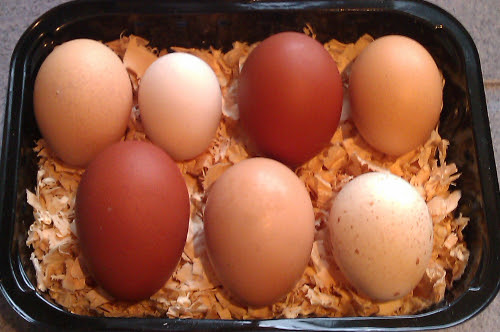
Whilst there is relation between egg shape and the sex of the Chick that hatches the p-value is very low. Also the process of measuring the egg is slow and complex and the net result is only about a 15% improvement in the number of hens that hatch.
This is not a big enough number for commercial producers to adopt it as a viable method of sexing chicks in the egg and none of them do it. The technique is also outside the ability of most backyard keepers as it is requires a volumetric and shape analysis and is more than just picking the pointed eggs out.
There is no reliable way for the average home hatcher to tell the difference between an egg that will hatch a female chick and an egg that will hatch a male chick.
An assortment of egg characteristics are supposed to be able to help you guess the gender of an egg. Apparently you can tell what sex of chicken will hatch out of an egg based upon the eggs shape, rounded top eggs will be females and the eggs that have pointy tops are the males. I have tried this and found that the proportion of males to females never changed in my hatches.
There was a study that looked at egg shape and hatchling gender and it did find some correlation but it was more complex that picking out the pointy eggs and required measuring equipment beyond the average keeper.
Sexing older chickens:
With some breeds it cab vary between difficult and impossible to sex the chicks and you have to wait for the secondary sexual characteristics to show before you are able to tell the boys from the girls.
When sexing older chickens between 2 and 12 weeks of age you need to look at the:
- Combs & Wattles.
- Leg size and stance.
- Feather Growth.
- Behaviour.
Combs and wattles: As a rule the combs and wattles on the roosters develop earlier than in the hens and by the time you get to 8 week old you should have an idea who the bulk of the males will be. This is breed dependant, with some like the Barnevelder and Welsummer it can be 12 to 16 weeks before the combs are distinct between the sexes.
Leg size and stance: Males have thicker legs and a more upright stance than the hens and this can often be seen from a very early age. Put the chicks in a clear plastic tote, get down to their level and look at the legs, the hens have daintier legs, often at more of an angle and the cockerels are bigger with a more upright stature.
Feather growth: In males the hackle feathers grow pointy and the hens are rounded. Some breeds have solid colour wing panels that appear in the males and not the hens and the tail feathers can be an indicator.
Behaviour: Male chicks behave differently to the hens and tend to spa and chest bump each other more than the hens do. Some are early starters when it comes to crowing and go through the motions even if they don't make the proper noise.
Other ways to tells hens from cockerels include the shape of the crest. In Polish and Silkies the shape of the head crest is said to be square in males and round in hens as chicks before the feathers start to show.
Conclusion:
I advise caution when sexing breeds that are not definite until they have developed, culling mistakes can be expensive. Birds used for breeding should be allowed to develop fully before being selected as faults can present themselves later on.
